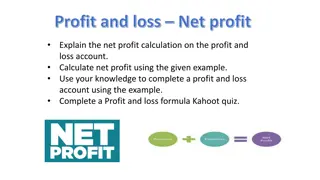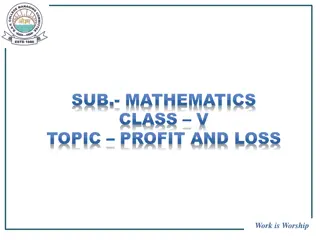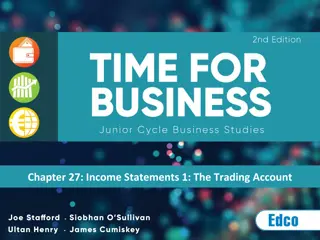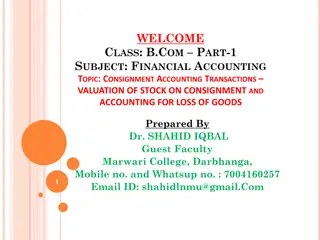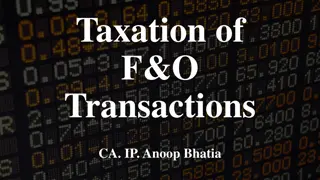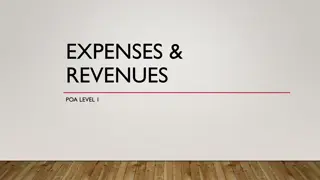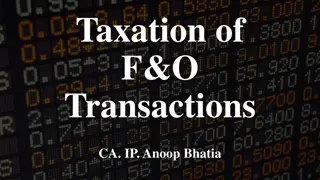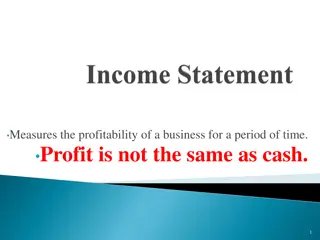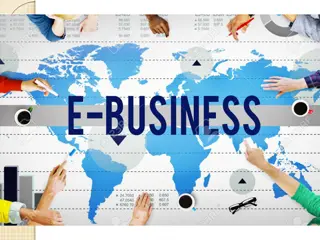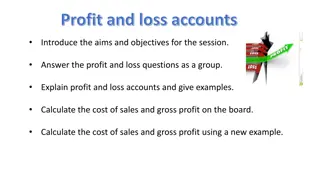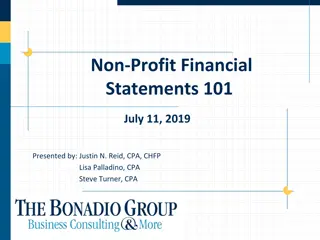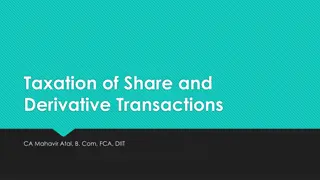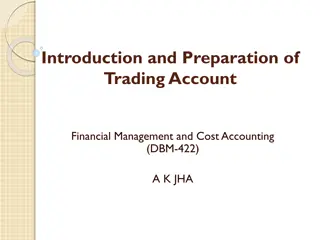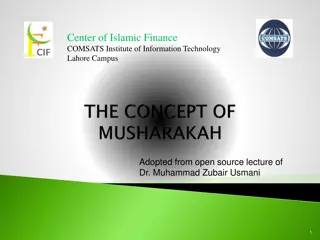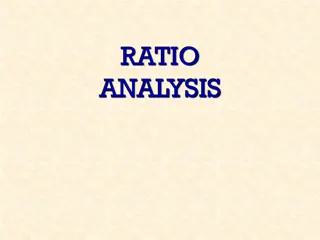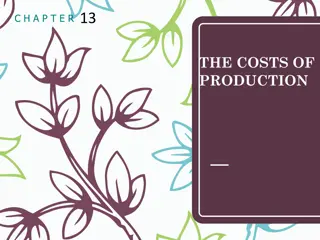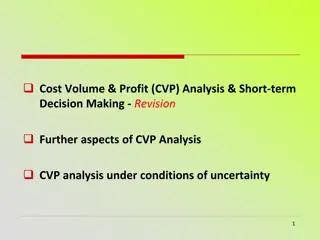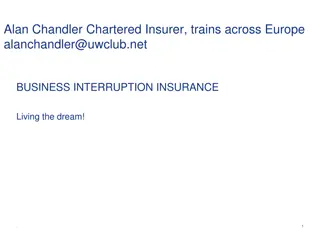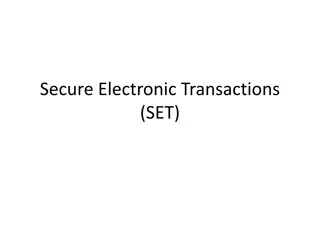Understanding Profit and Loss in Business Transactions
Learn about cost price, selling price, profit, loss, profit percentage, loss percentage, marked price, discount, successive discount, goods and services tax. Explore the historical context of profit and loss statements from the barter system to modern business transactions. Practice calculating profit, loss, discounts, and taxes through real-life scenarios.
Download Presentation

Please find below an Image/Link to download the presentation.
The content on the website is provided AS IS for your information and personal use only. It may not be sold, licensed, or shared on other websites without obtaining consent from the author. Download presentation by click this link. If you encounter any issues during the download, it is possible that the publisher has removed the file from their server.
E N D
Presentation Transcript
By the end of this lesson students will be able to : Define cost price, selling price, profit, loss, profit%, loss%, marked price, discount, successive discount, goods and services tax. calculate profit and loss. Solve problems related to profit% and loss%. calculate discount . calculate goods and services tax.
The first profit and loss statement could be traced back to the time where barter system was used. The small vendors could remember or wrote on a diary of their daily profit or loss. As trade between people grew many stake holders got involved in business and it became more complex together with the introduction of money in the form of coin.
Suppose your friend gives you Rs 150 for a pencil box that you got for Rs 125. You sell it to him and then buy a pen from him for Rs250. Later you find out that the pen was worth Rs200 . Did you lose money or did you make a profit?
When you do a business transaction like selling things if you earn some amount in the transaction that amount is called the profit and If you lose some amount then it is called loss.
COST PRICE: The amount paid to purchase an article or the price at which an article is made is known as its COST PRICE (C.P.) SELLING PRICE : The price at which an article is sold is known as its SELLING PRICE (S.P.)
If the selling price of an article is greater than the cost price, then the difference between the selling price and cost price is called profit /gain. S.P > C.P. PROFIT PROFIT = S.P. C.P. SELLING PRICE = C.P. + PROFIT COST PRICE = S.P. - PROFIT
Ans: Selling price = Rs 450 Profit = Rs 50 Cost price = S.P. Gain = Rs(450 - 50) = Rs 400 Again selling price = Rs500 Profit = S.P. C.P. =Rs(500 - 400) =Rs100.
The profit per cent is the profit that would be obtained for a cost price of Rs100. PROFIT % =
Ans Cost Price = Rs250 Gain =10% Gain amount = 10% of Rs250 =Rs Ans: : =Rs 25 Selling Price = C.P. + gain = Rs(250+25) = Rs 275
If the cost price of an article is greater than the selling price, then the difference between the cost price and selling price is called LOSS. C.P. > S.P. LOSS LOSS = C.P. S.P. SELLING PRICE = C.P. - LOSS COST PRICE = S.P. + LOSS
The loss per cent is the loss that would be obtained for a cost price of Rs100. LOSS % =
Q. By selling 42 oranges, a person loses a sum equal to selling price of 8 oranges. Find the loss percent. Ans: Let the S.P. of 1 orange = Rs 1 S.P. of 12 oranges = Rs1 12 = Rs12 Loss = S.P. of 8 oranges = Rs1 8 = Rs8 So, C.P. of 42 oranges = S.P. + Loss = Rs (42 + 8) =Rs 50 Loss% = = = 16%
Q. By selling a table for Rs 600 , a man earns a profit of 12% . How much did it cost the shopkeeper? Ans: S.P. of the table = Rs 600 Profit = 12% Cost price of the table = =Rs 500
Q . Ram sold an article to Gopal at 10% profit and Gopal sold it to Atul for Rs 440 at a loss of 20%. Find original price of the article. Ans: For Gopal, S.P. of the article = Rs 440 Loss % = 20 % Hence, C.P. of the article= = =Rs 550. For Ram, S.P. of the article = Rs 550 Profit = 10% Hence, its original price = = =Rs500. So, original price of the article was Rs 500.
To attract the customers, the shopkeeper offers certain schemes and rebates in order to increase the sale or clear the old stock. A rebate which is offered by the shopkeeper on the price of an article is called a discount. Discount is usually given as a percentage of the original price.
The price which is written on an article is called MARKED PRICE(M.P.) or LIST PRICE(L.P.) The price at which an article is sold is called its SELLING PRICE(S.P.) Selling Price = M.P. Discount Marked Price = S.P. + Discount Discount = M.P. S.P. Discount % =
Marked price = Rs. 400 Discount = 10% Profit = 20% Therefore, the Selling Price = 90% of 400 Therefore 400 x 90/100 = Rs. 360 Selling price = Rs. 360 Profit = 20% Cost price = 100/120 x 360 = Rs. 300
Q. At what price should an object be marked to make a profit of 20% on its purchase price 80 after being discounted by 20%? Solution: Here, CP = 80. SP = 20% increase (profit) on 80 (CP), Therefore, SP = (120/100) 80 = 96 Now, SP = 80% of MP, because of 20% discount on MP. Therefore, SP = (80/100) MP i.e. 96 = (80/100) MP MP = 96 (100/80) = 120 Q. At what price should an object be marked to make a profit of 20% on its purchase price 80 after being discounted by 20%? Solution:
Successive discount is the discount offered on the discount. The formula for total discount in case of successive discounts : If the first discount is x% and 2nd discount is y% then , Total discount = ( x + y - xy / 100 ) %
Solution: As the successive discount is 10% and 20% Solution: Total discount = ( x + y Total discount = ( x + y - - xy xy / 100 ) % / 100 ) % x = 10% and y = 20% Total discount = [ 10 + 20 ( 10 x 20) / 100] % = ( 30 200 /100 ) % Total discount = 28% Discount = 28% of 2250 Discount = ( 28 / 100 ) x 2250 Discount = Rs630 S.P = M.P Discount = 2250 630 Selling price = Rs 1620
GST is an indirect tax applicable throughout India which has replaced multiple taxes levied by the central and state governments. GST comprises Central GST(CGST) levied by centre. State GST (SGST) levied by state. Integrated GST(IGST) levied by centre on inter-state supply of goods and service. GST is charge on cost price of an article. Amount of GST = ??? % 100 X CP
Q. Rahim purchased a water bottle at Rs 330 including 10% GST. Find the price of the water bottle before GST was added. Ans: Price of the water bottle including GST =Rs 330 GST = 10% Let the price before GST was added = Rsx A.t.q, x+? 11? 10=330 x =300 So, the price of the water bottle before GST added was Rs300. 10=330
Based on Profit Profit and loss loss per cent: Collect the names of 5 grocery items. Collect the cost price and selling price of the items. Prepare a chart of profit/ loss per cent on each item.
FDDF PROFIT & LOSS C.P<S.P C.P >S.P PROFIT LOSS C.P = S.P NO GAIN NO LOSS
The amount paid to purchase an article is called its C.P. The price at which an article is sold is known as its SELLING PRICE S.P > C.P. PROFIT C.P.> S.P. LOSS Profit % and Loss% always calculated on cost price. Price marked on an article is called MARKED PRICE A certain percentage of rebate on the marked price of an article is called DISCOUNT. GST is an indirect tax used in India on the supply of goods and services. GST is charged on cost price of an article and it is added to the cost price of the article.



